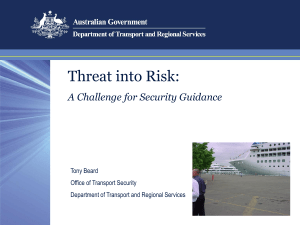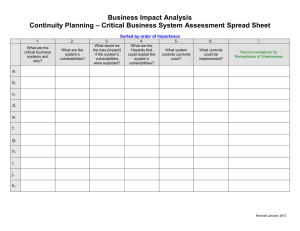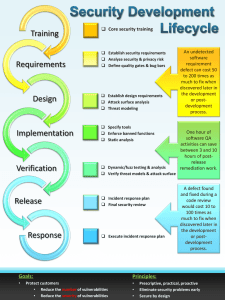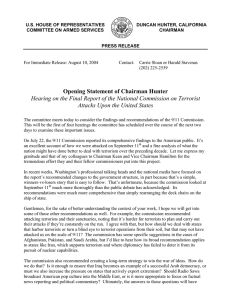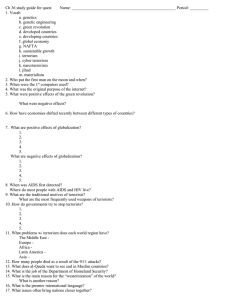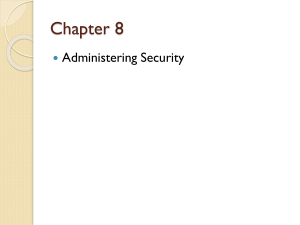Threat into Risk: A Challenge for Security Guidance Tony Beard
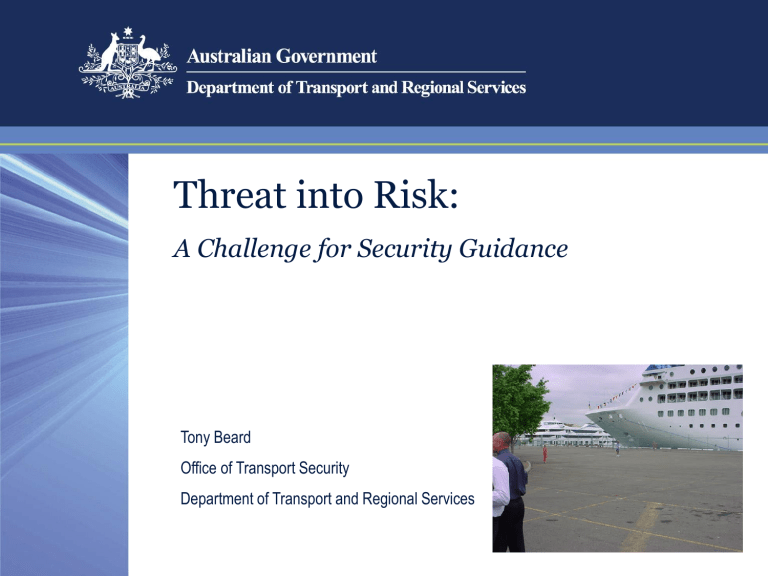
Threat into Risk:
A Challenge for Security Guidance
Tony Beard
Office of Transport Security
Department of Transport and Regional Services
Current Security Environment
Threats:
Al-Qa’ida and linked trans-national terrorism is the principal global threat
Transport, including maritime, remains an attractive target
Mass causalities through multiple, coordinated use of improvised explosive devices is preferred attack objective and methodology
National CT Alert level remains at MEDIUM
Issues in Defining the Threat:
“Home grown terrorism” does not help understand the terrorist threat
Radicalisation processes are poorly understood
Profiling is problematic and not the answer
Extremism can transcend national, social and family identity
Terrorists have demonstrated outstanding operational capability
Nature of the Threat
Transnational terrorism leads to traumatic, catastrophic consequences
Focus is on mass casualties
Terrorists have demonstrated intent and capability – coordinated attacks
There is constant heightened level of threat
Nature and level of threat means we Must Expect the Unexpected
There is likely to be no prior warning of attack
Criminal activity highlights vulnerabilities
The Threat to Maritime Security
The Maritime industry represents an attractive target because:
– Large shipments of dangerous cargo may provide a ready ‘weapon’
– Cruise ships concentrate large numbers of people
–
Infrastructure is accessible
Forms of terrorist maritime sector attack include:
– Hijacking of vessels (eg Achille Lauro, 1985);
– Boat-borne improvised explosive devices (eg Limburg, 2002);
– Sabotage / placed IEDs (eg Superferry 14, 2004);
– Assaults by commando-style teams (eg Seabourn Spirit, 2005);
– Stand-off weapon attacks (eg USS Ashland, 2005)
But international shipping can also be used for other purposes
– Infiltration of weapon of mass destruction (‘bomb in a box’)
–
Infiltration of terrorists (as crew, stowaways)
Limits of Intelligence
Strategic intelligence gives an insight into terrorist intent, capability
–
Useful in prioritising risks and developing preventative measures
–
Also helpful in focusing on key vulnerabilities
Specific intelligence identifying a particular target, time is unlikely
–
Cannot rely on attacks always being foiled ‘in the nick of time’
–
Security posture needs to reflect threat environment
Exploit terrorists’ vulnerabilities as they seek to exploit ours
–
Terrorists often need to conduct hostile reconnaissance
–
Encourage and enable resolution of suspicious activity
–
Engage with partners in government and industry
Criminal Threat to the Australian
Maritime Industry
Terrorism is a crime – not all crime is terrorism
Criminal activity highlights vulnerabilities in security systems which may be exploited by terrorists
Criminals want to preserve the transport system for their own ends
Terrorists want to destroy the transport system for their own ends
Organised and opportunistic crime threatens the integrity of the maritime sector
RISK: Frames of Reference
AS/NZS 4360 Risk Management
Corporate Risk
Regulatory Risk
Security Risk
A Security Risk Doctrine as the basis for Mitigation Planning
Government policy – prevention is a business cost.
Security risk management by industry
– 1. Non proscriptive regulation
– 2. Provides flexibility to owner/operators
– 3. It is not possible to eliminate all threats
Highly professional attackers – no prior warning
Probability of coordinated IED attacks on mass gathering
Traumatic and catastrophic consequences are untenable
Governments have NO RISK APPETITE
Focus on Vulnerabilities and Suspicious Activity
Preventive Security Requirements
Security must be a normal part of doing business
Board and CEO responsibility
Documented Security Plan for Risk Mitigation
Based on intelligence led security risk assessment
Including prioritised VULNERABILITIES
Prepared in consultation with internal & external partners
Ensuring reporting, logging and assessing security incidents
Providing for security awareness training to ensure identification and resolution of suspicious activity
“ Today we were unlucky, but remember we only have to be lucky once. You will have to be lucky always.”
- from a statement by the IRA addressed to
Margaret Thatcher
Building Key Partnerships
Partnerships harness and focus capacity
Security Risk Doctrine creates a common message for partners
Vulnerabilities are many and can exhaust resources:
– Need for focus and sustainability
– harness all human capacities
– utilise technology to aid human awareness – CCTV
Discussion Exercises (Desk-Top)
held routinely and regularly
to harness the capacity of all partners
against a common mental model
clarify:
- partnering roles and responsibilities
- policy and planning short falls
Partnership Objectives
To ensure:
Government agencies; Businesses and Communities are together creating an environment hostile to terrorist planning and preparation by:
– Identifying and mitigating vulnerabilities; and
– actively disrupting and resolving suspicious activity.
Security Awareness Raising
A common language is necessary
Security awareness training for staff, contractors and regular customers is essential
Security plans must include provisions for the reporting, logging and assessing of security incidents
Identification and resolution of suspicious activity is essential
Vulnerabilities
Vulnerabilities potentially amplify terrorist capabilities and therefore increases the chance of a risk eventuating
Vulnerabilities must be prioritised to focus and ensure proportional targeting of risk mitigation strategies there by best utilising resources
Vulnerabilities should be prioritised through an intelligence led assessment of likelihood and an understanding of the local security context.
The Challenge
Ensuring that even if the bomb doesn’t go off this week:
Government remain focussed
Industry remain vigilant and prepared
Public interest and awareness is sustained
Summary
Terrorist response must be focussed, proportional and recognise:
– Constant heightened level of threat
– Terrorists display personal and professional capability
– No prior warning of attack
Risk based approach provides common language, ideas and focus
Our operating environment is complex and sound partnerships are essential to achieving an effective response
Government, industry and the public must remain focussed and alert to identification of suspicious activity
